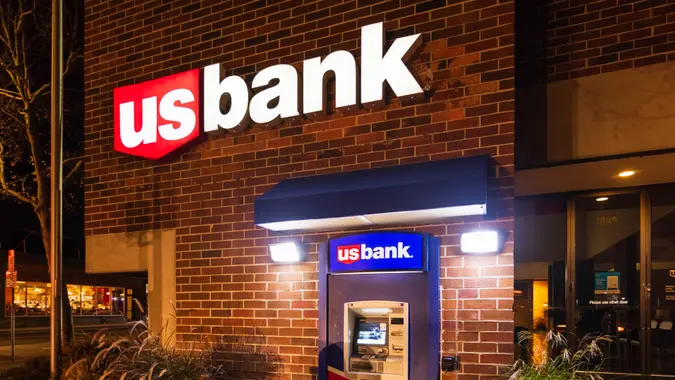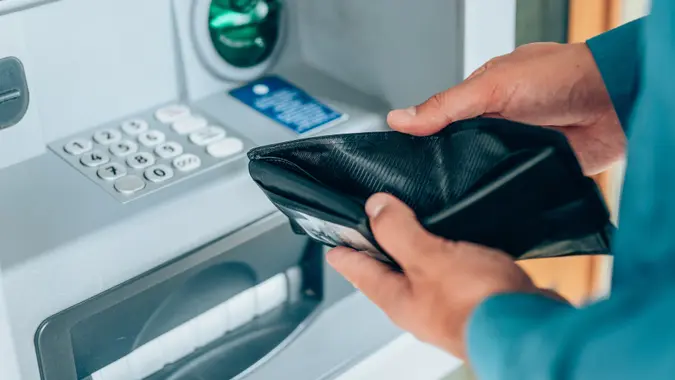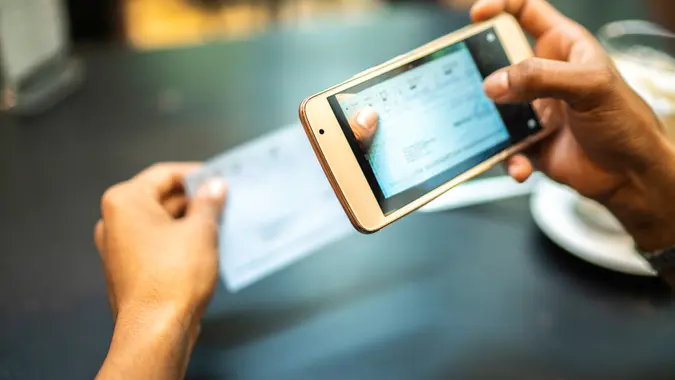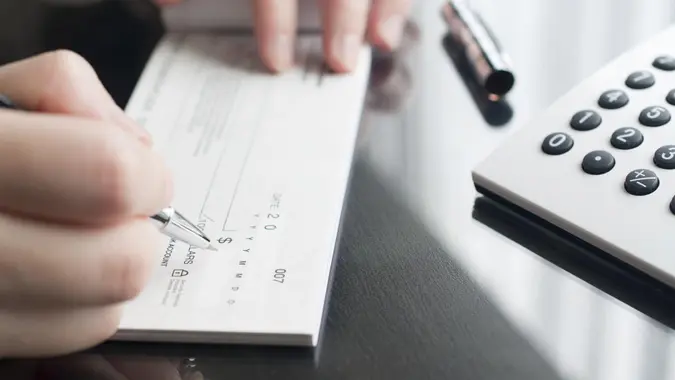What Is the Maximum Amount for a Cashier’s Check?

Commitment to Our Readers
GOBankingRates' editorial team is committed to bringing you unbiased reviews and information. We use data-driven methodologies to evaluate financial products and services - our reviews and ratings are not influenced by advertisers. You can read more about our editorial guidelines and our products and services review methodology.

20 Years
Helping You Live Richer

Reviewed
by Experts

Trusted by
Millions of Readers
Cashier’s checks are a reliable payment method, especially when handling large transactions where personal checks might not suffice. Often used in significant financial dealings like buying a house or car, they come with the assurance of a bank’s backing, making them a safer and more trusted form of payment.
When it comes to dealing with substantial amounts, one might wonder about the limitations. What is the maximum amount for a cashier’s check? Understanding these boundaries is important for anyone planning a major purchase or transaction.
What Is the Maximum Amount for a Cashier’s Check?
Most cashier’s checks do not have a hard upper limit. That makes them great for large purchases, but they have some unwritten limits.
The first limit is your checking account. If you have a $5,000 balance on your checking account, you can’t write a $10,000 cashier’s check to someone. The amount of a cashier’s check can go as high as the available balance in your bank account. However, it’s essential to check with your specific bank as policies might vary.
A second limiting factor to keep in mind, banks have to ensure they have enough liquidity to fulfill internal policies and legally assigned goals. Some banks set limits to ensure they have enough available funds after issuing the check based on their policies.
Good To Know
Large financial institutions like Citi® or Bank of America, Member FDIC, tend not to have any specific limit for cashier’s checks. You can write a cashier’s check well over $1 million if you have enough funds.
Credit unions tend to have limits for their cashier’s checks since they are smaller institutions. For instance, the Navy Federal Credit Union limits cashier’s checks to $2,500 if it is mailed. You can get a higher limit if you visit a branch or make an online order.
Common Misconceptions About Limits
One of the most common misconceptions about cashier’s checks is that banks are required to set a limit. There is no maximum cashier’s check as long as the consumer has a sufficient balance and the bank has enough liquidity. Smaller banks tend to have smaller limits than large financial institutions.
Another misconception is that banks and credit unions offer the same limit regardless of how you send the check. Navy Federal Credit Union is one of the financial institutions that debunks this misconception. The credit union has a lower limit for mailed checks than ones you buy online or pick up at a local branch.
Why Use a Cashier’s Check for Large Transactions
A cashier’s check offers enhanced security since the bank guarantees the funds. These checks reduce the risk of fraud and receive wider acceptance from sellers for large purchases.
Cashier’s checks are frequently used for large real estate transactions and vehicle businesses. They are also popular payment methods for large business transactions. The seller can feel more assured that the check won’t bounce and that it is a secure transaction.
What Happens If You Exceed the Limit?
Exceeding the limit for a cashier’s check means your bank may deny the request or suggest alternative payment methods. Banks have some limits in place to ensure they have enough capital at hand to fulfill legal requirements and operational policies.
Many banks may balk at the idea of you taking out a $100 million cashier’s check, and the maximum limit also depends on the bank’s size. Smaller banks usually have lower limits to minimize their risk.
Options for Larger Amounts
If a bank doesn’t have a high enough cashier’s check for your purchase, there are still some ways to get the necessary funds. These are some of your options:
- Wire transfers: These transfers typically take 1-3 business days, and banks have fraud protection set up to make these transactions more secure. However, you can pay up to $35 for a domestic wire transfer, and international wire transfers are usually more expensive.
- Splitting payments: You can make a partial payment with one cashier’s check and request a second cashier’s check afterward. Those two cashier’s checks may be sufficient to complete the purchase.
- Bank drafts: For a bank draft, the bank verifies that you have enough money and then moves the funds to a reserve account. The bank essentially acts as a third party for the deal.
- Certified checks: Banks can certify personal checks and give their stamp of approval, essentially telling the seller that you have enough funds to complete the purchase. The only risk is that someone can move funds out of their checking account shortly after receiving a certified check.
How To Get a Cashier’s Check
To get a cashier’s check, you can follow these steps:
- Ensure sufficient funds: Before requesting a large cashier’s check, verify that your bank account has enough funds to cover the check amount. Remember, the bank will immediately withdraw this amount for the cashier’s check.
- Visit your bank: Go to your bank in person. For substantial amounts, face-to-face interaction is often necessary and more secure.
- Request the cashier’s check: At the bank, inform the teller that you need a cashier’s check. Be ready to provide specific details like the exact amount and the payee’s name.
- Verification process: For large sums, the bank will likely perform additional verification. This could include confirming the purpose of the check and ensuring the funds’ legitimacy.
- Pay any associated fees: Be prepared to pay a fee for the cashier’s check. The fee amount can vary depending on the bank and the check amount.
- Collect your check: Once all verifications are complete and the fee is paid, the bank will issue your cashier’s check. Ensure all details on the check are correct before leaving the bank.
- Secure your receipt: Always get a receipt for the transaction. This serves as proof of the check’s issuance and can be vital in case of any discrepancies or issues.
You will need your bank account details and a valid photo ID during this process. You will also have to specify how much funds you need for the check. Preparing documents in advance and calling ahead can make the process smoother, as you will have the opportunity to confirm the bank’s policies.
Safety Considerations for Large Amounts
Handling a large cashier’s check often requires extra precautions. Banks might need to verify your funds and the reason for a large transaction, especially if your account is new or has had recent changes. These security checks help prevent fraud and ensure the transaction follows banking rules and anti-money laundering laws.
Costs and Fees for Cashier’s Checks
Most cashier’s checks have a fee that ranges from $10 to $20. However, this fee varies for each financial institution.
Factors Affecting Fees
The type of bank account you use will affect your fee, as some premium accounts let you waive the fee. Furthermore, bank and credit union policies will influence how much you pay.
Some financial institutions are more generous with their fees than others. Banks with thousands of physical branches tend to have higher fees to compensate for the overhead.
Comparing Costs
It’s good to compare cashier’s check costs at multiple financial institutions. You might find banks that waive the fee or have a lower cost for alternative payment methods. However, you shouldn’t go too deep into this search if you rarely use cashier’s checks, as most of these checks have a $10 to $20 fee. Comparing something else like APRs on multiple mortgages will have a far more significant impact on your long-term finances.
Final Take
With no standard upper limit, a cashier’s check offers flexibility, provided you have the funds in your bank account. Whether it’s through a checking account, savings account or even a CD account, ensure that your bank account can support the amount you plan to transact.
Always consult with your bank to understand any specific rules or requirements they may have regarding cashier’s checks, especially for large amounts. This precaution helps in preparing for significant financial dealings without any surprises.
FAQ
Here are the answers to some of the most frequently asked questions regarding cashier's checks.- Do all banks issue cashier's checks?
- Most banks issue them, but some financial institutions only give cashier's checks to their customers. Non-customers may have to pay an additional fee and undergo a more detailed verification process.
- How quickly can you get a cashier's check?
- You can receive a cashier's check right away at a local bank.
- Are cashier's checks refundable?
- In most cases, cashier's checks are not refundable. Loss, theft and fraud are three notable exceptions where you can get a refund, but it's good to check the bank's policies first.
- Can a cashier's check bounce or be declined?
- Cashier's checks cannot bounce since the bank has ensured them. Banks accept cashier's checks most of the time. The only times a cashier's check may be declined is if a bank sees something suspicious with the check, such as a fraudulent signature.
Elizabeth Constantineau contributed to the reporting for this article.
Our in-house research team and on-site financial experts work together to create content that’s accurate, impartial, and up to date. We fact-check every single statistic, quote and fact using trusted primary resources to make sure the information we provide is correct. You can learn more about GOBankingRates’ processes and standards in our editorial policy.
- IRS. 2023. "IRS Form 8300 Reference Guide."
 Written by
Written by  Edited by
Edited by 
























